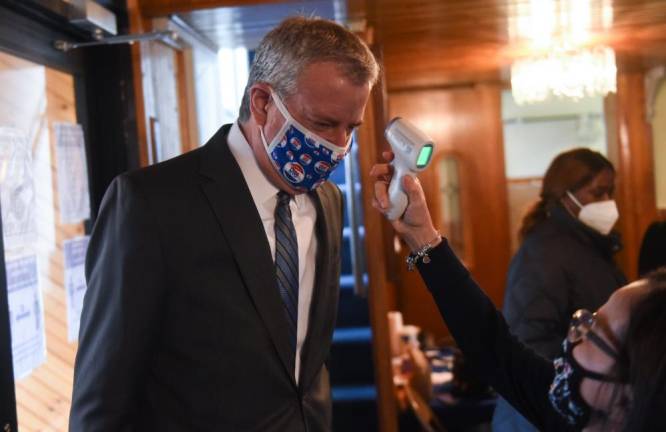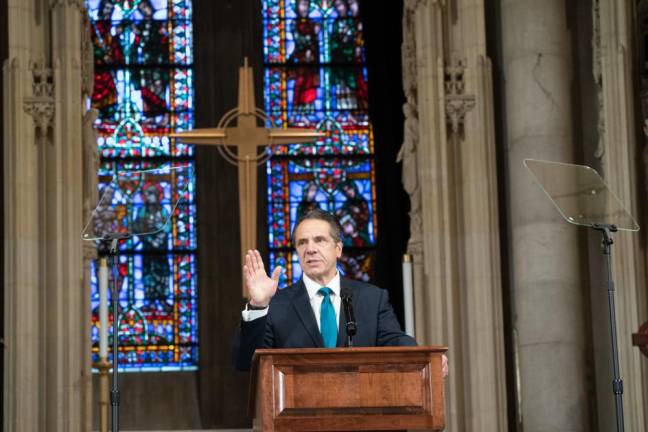Not So Positive About the Data
Cuomo tells de Blasio he should use different metrics to decide school closings


As the COVID-19 contagion continues, we have become obsessed by data we had never even heard of a year ago. Take 2.77 %, for example. Mayor Bill de Blasio announced that figure Monday with some satisfaction because, he said, it meant New York City schools could stay open for in-person classes, at least for another day.
“Every day that we can keep our schools open is a blessing for our children and our families,” the mayor had said Sunday.
The figure 2.77 % is the portion of tests for COVID-19 that came back positive across all of New York City, averaged over the last week. The mayor had announced that if this “positivity rate” went over 3% he would halt in-person schooling, returning many working parents to the crisis of balancing care for their kids with their own work.
So it is no surprise that many parents follow this figure like epidemiologists. Now it should be noted that real epidemiologists do track this positivity ratio carefully, too.
Yet the positivity rate is only one of 15 COVID-related metrics described as vital in a report Monday. “To control COVID-19 effectively, it is important that everyone have clear access to relevant, uniform data across jurisdictions,” said Dr. Tom Frieden, former CDC director, whose NGO, Resolve to Save Lives, released the report.
The larger point is that no single metric captures the entire picture of coronavirus and, therefore, decision makers should not lean too heavily on any one metric.
It isn’t altogether clear why de Blasio ended up with 3% citywide positivity as his tripwire to stop in-person schooling. Some other school systems are using higher rates and Governor Andrew Cuomo has been leaning on the mayor to use more localized figures.
Enough Tests
To epidemiologists, the positivity rate is first and foremost a measure to make sure enough tests are being conducted.
So when Washington Heights reported a 5.23% positivity rate last week it turned out that the number reflected that too few tests were conducted, not necessarily such a high case rate (although it will take more testing there to know).
A larger imperfection, however, is that even when there are enough tests conducted the citywide rate is a blunt instrument concealing a great deal of neighborhood variation, from the 6.55 % in Breezy point to 0% in Battery Park City, where no one tested positive.
The Upper West Side (10024) reported a 1.41% positivity rate, Chelsea (10011) was 1.78% while Yorkville and the Upper East Side (10028) was 1.89%.
Mayor de Blasio implicitly acknowledged the disparities when he said he was talking to Governor Andrew Cuomo about a reset that would switch to more localized metrics. “If the school is below a certain threshold, let that school reopen,” Cuomo said Monday.
The governor called this a “second calculus” for determining safety, although it isn’t clear whether the city and state can ramp up testing in schools enough to meet the governor’s goal.
Also, Cuomo explained, “the parents and the teachers have to agree. There is no fiat here.”
Ranking System
The governor has been emphasizing cordoning off hot spots to keep COVID under control, and has developed a color-coded ranking system. Indeed, as part of this he had shut down schools in parts of Brooklyn and Queens for a while.
The mayor said he would be open to a more neighborhood calibrated system for the schools, although first he would close all schools if the city hit 3%.
“If we reach this 3% level, God forbid, but if we reach it, we’re going to have to do some type of reset,” de Blasio said Monday. “It’s not a matter of saying ‘oh, just let’s forget we had that.’ No, that was a rule we made to keep faith with people and show our commitment to safety. We’re gonna live by that rule. But the question is, how do we come back as quickly as possible?”
The mayor said he had “some really good conversations” with the governor about such the more localized system.
“I agree with the governor, a different approach to testing could be a crucial part of a comeback,” de Blasio said.
Vaccine Breakthroughs
This challenge is likely to continue through most of the school year. Two biotech companies, Pfizer and Moderna, announced breakthroughs in their separate clinical trials of vaccines they are developing.
Each company says late stage trials show their vaccine to be highly effective in protecting against COVID-19. Based on this, the companies said they will each soon ask the Food and Drug Administration for approval to begin making emergency distributions.
Between them, Pfizer and Moderna have enough vaccine to immunize about 30 million Americans by the end of the year. So government officials will have to decide how to ration the available doses until more becomes available next year. Most likely the first phase will cover frontline workers, followed by older and immune compromised populations.
But there have been arguments that younger, more mobile working age people should be vaccinated as quickly as possible to stem super spreader events and allow the economy to return to normal as quickly as possible.
Either way, widespread vaccination probably will not be achieved before sometime next year, according to Anthony Fauci, the government’s leading infectious disease expert..
Cuomo has criticized the Trump administration’s plans, saying they do not do enough to assure supply to communities of color which have been hard hit by the pandemic. The governor has also said he will subject the vaccines to a review by experts appointed by the state of New York, to assure New Yorkers it hasn’t been rushed into use.
If the governor doesn’t want the vaccine, President Trump replied Friday, New Yorkers won’t get it.
Frieden’s report was a follow-up to a study in July. The availability of data has improved in many states. New York makes it possible to check online the result of in-school testing.
But overall the availability of crucial data is still far short of what is needed, he said. New York, for example, still does not have or does not make available most of the 15 metrics his work suggests are crucial for understanding the pandemic.
“Several states, including New York and Maine, have excellent responses, but gaps in public availability of data,” Frieden said.
“If we reach this 3% level, God forbid, but if we reach it, we’re going to have to do some type of reset.” Mayor Bill de Blasio